The WELL ��ɫ����TV Standard, focusing on human wellbeing and updated last year, can transform occupier fit-outs. Kristopher Allen, Chris Lalies, Jon Buckle and Joe Rutledge of Alinea explain the benefits and examine the experiences of two occupier companies
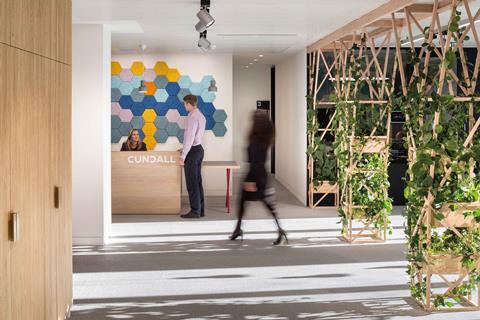
01 / The WELL ��ɫ����TV Standard – What has changed since 2017?
In May 2017 an article in ��ɫ����TV considered the WELL-enablement of offices – including what developers could do to enhance their base building from a WELL perspective, as well as how tenants could do likewise with their fit-outs. Since then the WELL ��ɫ����TV Standard has been updated, with the launch in May 2018 of WELL v2. This article focuses on WELL from the tenant or occupier’s perspective, addressing those parts of the WELL standard that relate to fit-out, including how it can contribute to health and wellbeing.
To begin, a reminder of what WELL is and how it has developed.
WELL then
In the International Well ��ɫ����TV Institute’s (IWBI) words, WELL is “the premier standard for buildings, interior spaces and communities seeking to implement, validate and measure features that support and advance human health and wellness”. Or in project terms, WELL is a rating system – not unlike BREEAM, SKA, LEED or Fitwel – but with a primary focus on the health and wellbeing of building users.
This assertion is supported by the British Council for Offices’ (BCO) Wellness Matters publication, which indicates that WELL covers the most “wellness matters” outcomes overall and that, alongside Fitwel, they cover two to three times more outcomes than BREEAM, SKA and LEED. It is important to recognise that the rating systems all have different objectives, with the latter three placing more emphasis on environmental matters.
WELL is broken down into two main areas. WELL Core addresses base build factors and is geared towards developers seeking to WELL-enable a building. A series of concepts can be targeted at this stage to produce a WELL-certified base build, enhancing a prospective occupier’s ability to obtain WELL certification with its fit-out. This leads us to WELL Certification generally, where occupiers can gain certification on the fit-out of their workplace. Both areas have a set of mandatory preconditions, plus optional optimisations that allow the user to pick a pathway to higher classifications (Silver, Gold and Platinum). Examples of the concepts and typical enhancements are demonstrated in figure 1.

What has changed?
WELL v2 introduces two new concepts – “materials” and “community” – while the previous “comfort” concept is split into “thermal comfort” and “sound”, as demonstrated in figure 2. While not identified separately as a concept, additional points are also available for “innovation”. WELL v2 is considered more flexible by some because a number of preconditions became optimisations, which arguably gives the user greater choice around their pathway to achieving WELL.
The IWBI has introduced a further certification route called WELL Portfolio that lends itself to clients with multiple assets, enabling them to adopt WELL under a framework arrangement.
Rising awareness
The link between the wellbeing of building occupants and their internal working environment is not a new concept: the first version of BREEAM in 1990 addressed “indoor effects”, and studies in the early 2000s looked at the impact of carbon dioxide concentrations in laboratory conditions. Influencers such as the BCO have also placed the subject on their agenda.
The topic has gained traction in recent years, with the release of publications such as Improving Productivity in the Workplace and Wellness Matters in 2018, and wellness features becoming embedded into recognised documents such as the BCO Guide to Specification 2019. Such publications incorporate the evolving body of research, feedback, and data harvested from pre and post-occupancy evaluations.
Research
Some bold statements have been made on the possible improvements to wellbeing through workplace strategies, in particular claims for the productivity improvements that can be achieved. The World Green ��ɫ����TV Council says “productivity improvements of 8%-11% are not uncommon as a result of better air quality”. Pre and post-occupancy surveys, including those conducted by Leesman, are providing valuable insight into employee perception and what constitutes a high-performing office, while research published by Harvard and Oxford Brookes universities considers the link between cognitive function and internal working environment.
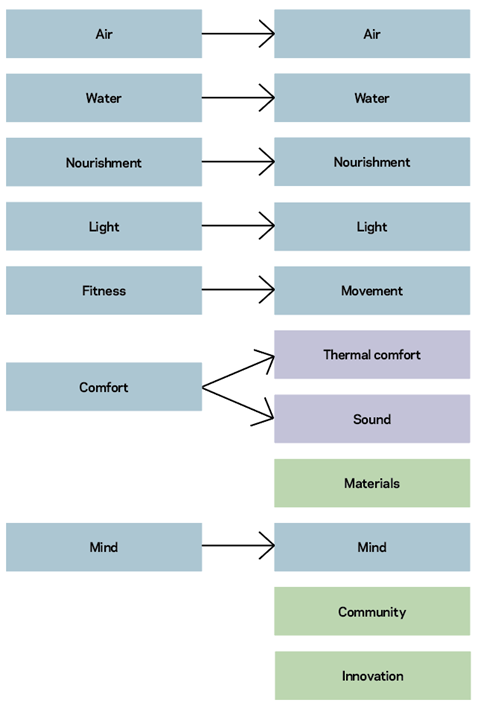
02 / What cccupiers can gain from WELL
The individual
A recent survey undertaken by Aon found that 97% of businesses felt workers were expecting more of their employers in areas such as mental health support, diversity and inclusion, flexible working and environmental control. Considering that we spend a significant proportion of our lives at work, this brings into sharper focus the importance of our working environment.
While there are organisational factors in how employee expectations are fulfilled (or not), which are largely influenced by a business’ management and culture, this article concentrates on the physical factors that can be influenced by the design team.
Notwithstanding the difficulty in assessing the relative values of organisational and environmental factors, both pre and post-occupancy surveys offer overwhelming support for the notion that indoor environmental factors play a significant role in satisfaction levels as well as staff attraction and retention metrics.
The Future Workplace study undertaken in North America, in which employees were able to convey which environmental factors matter most to them, concluded that indoor air quality was the most significant. This is supported by a 2019 survey of European office workers undertaken by Savills, in which air quality was valued alongside lighting but behind cleanliness and comfort.
The organisation
The business case for addressing wellbeing issues is also compelling, from a number of perspectives.
Absenteeism: One of the most familiar metrics is around absenteeism, or the amount of time spent absent because of illness. Depending on the source, average absenteeism in the UK is estimated at between four and six days per employee each year. For a business of, say, 100 staff – assuming an output of £150,000 per fee earner per year – that would equate to about £3,500 of unharnessed fee per person or £350,000 to the business in a year.
A review of case studies where pre and post-occupancy data has been published indicates improvements of 30% on average – which, in the case of the theoretical business above, would equate to a saving in the region of £100,000.
Productivity and presenteeism: Of even greater impact on a business is the effect of presenteeism: being at work while ill and ultimately less productive and spreading illness to others. This is more difficult to measure, but is estimated to cost UK employers two to three times as much as absenteeism.
Research supports claims that potential productivity improvements of up to 14% can be associated with a single environmental factor: carbon dioxide. The multitude of other relevant factors – including relative humidity, thermal comfort, daylight and acoustics – suggest the potential improvement to cumulative business productivity is high.
Staff turnover: This can range from 5% to 15%, depending on the data source. While staff turnover is not necessarily a negative indicator, consistent churn can be disruptive as well as costly. It may also be indicative of a sub-optimal working environment.
Some sources suggest the costs to a business of excessive churn are between 33% and 200% of an employee’s salary, with average total costs of between £11,000 and £31,000. Oxford Economics, which is responsible for the £31,000 estimate, suggests that £25,000 of that is associated with lost output/productivity, as employees take on average 28 weeks to settle into a new role. However it is cut, the figures are significant.
Taking the above into account, and again looking at a business of 100 staff, this suggests turnover could cost from £155,000 to £465,000 a year.
In one set of data on staff retention, a possible improvement of 27% was cited following occupation of a WELL-certified workplace. When applied to the business case above, this would equate to between £40,000 and £125,000 a year in reduced staff turnover costs.
Mental health: According to the Chartered Institute of Personnel and Development, the single largest cause of long-term absence from work is mental ill health (59%), followed closely by stress (54%).
Aside from the ethical and legal considerations, there is a serious commercial argument for addressing aspects of the workplace environment that are detrimental to mental health. Deloitte estimates that mental ill health costs UK employers between £33bn and £42bn per year.
Stronger links between the workplace environment and mental health are beginning to be found, with studies drawing strong connections between mental health and biophilic design (the positive effect of green space) as well as good nutrition. In addition, people have been shown to be four times happier when connected to others at work.
These are all factors that can be influenced or encouraged through the physical work environment.
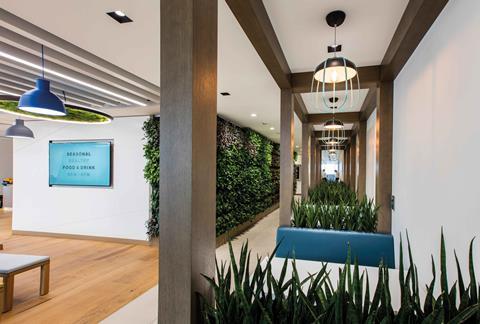
03 / Insight from occupiers that have achieved a WELL-rated fit-out
Two organisations that have achieved WELL certification for the fit-out of their premises – and reaped the benefit of incorporating health and wellbeing features – are the Crown Estate, which obtained WELL Platinum in September 2018 for the fit-out of its head office at St James’s Market in London, and Cundall, which achieved WELL Gold in November 2016 for its London office at One Carter Lane.
Cundall’s was the first office in Europe to achieve a WELL certification, while the Crown Estate’s was the first in Europe to achieve a WELL Platinum rating. Both organisations have been occupying their spaces for sufficient time to provide feedback based on their experiences in use.
Why consider WELL from the outset?
Both Cundall and the Crown Estate gave similar reasons, with the main themes being people and productivity.
The Crown Estate says: “We wanted to create a workplace which offered our people the very best environment to work, enhanced their productivity and supported their wellbeing. We also understand the important role that the office environment plays in the attraction and retention of talent. Workspaces have become a differentiator and people expect the very best spaces and facilities when they come to work – and rightly so. The WELL standard reflects our commitment to achieve both these things.”
Given that Cundall is a consultant expert in workplace health and wellbeing, it is perhaps unsurprising it took more of an experimental approach: pursuit of WELL certification was only part of Cundall’s aspiration to improve employee wellbeing.
The company wanted to create a “practical expression” of its long-standing focus on sustainability and wellbeing and to experiment with some of the research it had undertaken. It also saw an opportunity to showcase its office as an exemplar to clients and collaborators. The firm is vocal about the links between workplace environment and productivity, and the advantages of ongoing monitoring and testing.
What challenges were encountered with the base build in achieving WELL?
With the variety of commercial space available, and the possibility of inherent base-build constraints, challenges are inevitable on any fit-out. But given the number of enhanced requirements prescribed by WELL, some of which are associated with the base-build, it stands to reason that for an tenant, achieving WELL may not always be straightforward.
The Crown Estate talked about how the building it was moving into was set behind a retained facade. Historic buildings are often heavily constrained and do not lend themselves to an efficient, modern-day workplace setting. Luckily for the Crown Estate, however, the base build and retained facade had been undertaken to a high standard.
It was also fortunate in that the building possessed non-typical high ceilings, driven by the facade. This, combined with a central atrium, provides good natural light.
These conditions could have presented challenges in another fit-out. While tall windows maximise natural light, they can also enhance the risk of direct sunlight or glare – a detrimental factor as far as human comfort and WELL are concerned.
The success of a retained facade is heavily dependent on the detailing, and heat loss or drafts caused by a “leaky” facade can be detrimental to wellbeing. Apart from thermal discomfort, leaky facades can allow the penetration of pollutants such as nitrogen dioxide and airborne heavy metals, prolonged exposure to which are linked to respiratory issues and damage to major organs and the nervous system. This is an evolving area of research but gaining recognition.
For Cundall, the two biggest challenges it encountered with the base build were associated with air and water quality – both fundamental requirements to achieving WELL. Water-quality issues were resolved by installing filters, but the air-quality issue called for a more imaginative approach. They found that densely occupied spaces, such as meeting rooms, were not receiving adequate fresh air. To address this, Cundall installed a demand-driven control system that reacts to the carbon dioxide content in the return air ducts, redirecting fresh air to areas of greatest need.
What features are seen as particularly beneficial by users?
There were overriding themes in both fit-outs of giving individuals access to natural light and encouraging collaborative working and social interaction through a variety of meeting spaces. Cundall is particularly proud of its “town hall” space and how it sparks interaction.
The Crown Estate has received positive feedback on the acoustic performance of its meeting rooms. To have a variety of spaces available and be able to traverse a vibrant office space then duck into a quiet adjoining meeting room is seen as a great advantage.
For Cundall, a feature that shone through was air quality, with staff actually noticing the improvement. During the first couple of years of monitoring indoor air quality in occupation, readings were consistently good. Then a sudden spike in carbon dioxide concentrations (from 700-800ppm to 1,300-1,400ppm) alerted it to a ventilation imbalance caused by fit-out works elsewhere in the building. Cundall estimated this could have had a 10%-15% impact on the firm’s productivity, yet it was discovered only because air quality was being monitored.
What features are considered less popular by the users?
Neither Cundall nor the Crown Estate were able to give many examples of unpopular features. This is perhaps because both organisations created a significant improvement from the baseline of their previous offices. They described the experience as a process or journey, constantly adapting in response to the way the space is used.
Given Cundall’s early adoption of WELL, it received a lot of interest in visiting the new space, with suppliers offering to participate by providing products to be tested. This included a furniture provider that lent the company a number of treadmill and cycle desks, as well as desk steppers and balance boards. These ultimately received mixed but useful feedback from staff.
Can wellbeing be measured?
Perhaps one of the most defining aspects of WELL is the call for pre and post-occupancy evaluation using surveys. Both the Crown Estate and Cundall have participated in this, but using different methods: Cundall opted for the BUS (building use study) approach and the Crown Estate for its own One Voice survey. Both produced startling results.
Cundall shared survey results on three measurement criteria:
- Perceived wellbeing, up 25 points to 76%
- Sense of community, up 28 points to 79%
- Enjoyment in the environment, up 48 points to 82%.
The Crown Estate found that 88% of its staff said they felt the employer cared for and nurtured their wellbeing, a rise of three points since moving to the new offices. Another interesting metric it has been monitoring is cafe sales, in response to changes in product offering. After the introduction of a healthier menu and smaller portions, sales rose by 25%.
Is productivity up?
When posed the same question about improved productivity, the results were staggering. Both the Crown Estate and Cundall shared results from their surveys indicating estimated productivity improvements of 25% and 27% respectively. The Crown Estate, using the Leesman+ benchmark, was able to demonstrate that it fell in the top 2% of offices worldwide.
Occupancy surveys are a good way to analyse general perceptions and trends, but they possess an element of subjectivity. In fact, there are indications that perceived satisfaction levels can return to normal as soon as three years after the honeymoon period. Cundall believes that measured, quantitative performance can make a more compelling argument.
In HR terms, Cundall cited absenteeism rates reducing 22 points further than what would be expected of a typical new office development (a 49% reduction, compared with 27% on average). This equated to a £90,000 annual saving for the company. Staff turnover was also down 27% in the year, compared with stable levels for the five years before the move, equating to a £122,000 annual saving.
Cundall has also developed its own productivity mapping tool, which indicated a 2.6% increase in productivity when compared with the firm’s previous office.
Lessons learned
The Crown Estate feels that, while it had made a concerted effort in engaging with and educating its team ahead of the move, it had not placed enough of a dedicated focus on the WELL standard and its importance. It considers it should have provided more education about how WELL exists to benefit occupants, including that “it is about so much more than ergonomic chairs and healthy meals”.
The incorporation of biophilic features such as green walls has been such a success – it is the feature loved most by visitors – that the Crown Estate wishes it had been braver and experimented more with this.
Cundall emphasises that WELL certification is only the starting point, “a journey, not a destination”, as it calls for continuous measurement, improvement and ultimately effort. In fact, three years later its office needs reinvigorating: this is a product of continuous learning around high-performance workspaces and the fact that it has partly outgrown the space, perhaps as a result of its success.
Cundall explains that generally the strength of the WELL standard is its focus on performance in use, but there can be issues where it relies on design standards. One example of this is the thermal comfort feature, which One Carter Lane achieved despite Cundall experiencing cold draughts through the “leaky” facade in winter. If this feature had been a performance-based criterion, One Carter Lane would have struggled to achieve it.
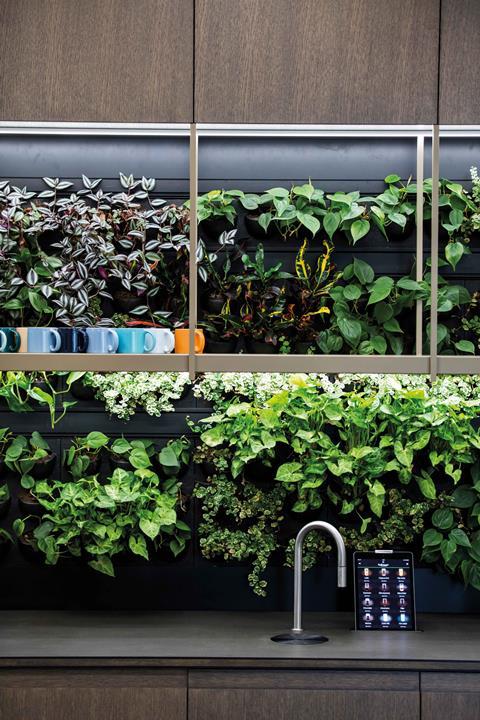
04 / Case study: Crown Estate head office
- Occupier: The Crown Estate
- Business type: Property
- Location: St James’s Market, London
- Project team: Buro Four, Edge, Watkins Payne, Cundall, Alinea, ISG
Objectives
Staff had previously been spread over four floors and the Crown Estate sought to bring them all onto one floor, while providing on the top floor an in-house cafe, meeting spaces and a dedicated visitor experience. At the heart of the project was an ambition for the new workspace to embody the Crown Estate’s stated purpose: “Brilliant places through conscious commercialism”. It aimed to move to agile and activity-based working to respond to the changing needs of the business and its people. It wanted a space that would encourage interaction and empower collaboration. There are more than 450 different workspaces in the new office, ensuring the team can always find a space to work that suits their needs. This includes a mix of formal working areas, sit/stand desks, interactive hex-desks and collaboration spaces.
Key challenges and successes
Further developing the base building at St James’s Market, which prioritised natural light with a central atrium and extra-height ceilings, the office layout was designed to maximise access to daylight for all. The entire office is open plan, with senior leaders opting for flexible desks situated throughout the floorplate and smaller meeting rooms placed within the interior. The office design also incorporated a variety of flexible spaces such as the library, which can be used for quiet work or “town hall” gatherings, and the media lounge, which is a hub for news and is used for staff briefings.
Interesting features were woven throughout the two floors, including internal living walls and moss-applied walls and booths, providing the psychological benefits of green space while also enhancing acoustics. Drinks stations are positioned away from the office floor to minimise the impact on colleagues, while the Market Café is both in-house cafe and informal meeting area, offering striking views of the London skyline. Throughout both floors, furniture, fixtures and finishes with a low-VOC solvent content were selected to optimise indoor air quality, alongside timber flooring and furniture using oak sustainably sourced from the Crown Estate’s own holdings. Comprehensive environmental monitoring and controls were provided to enhance wellbeing as well as gain sustainability credentials including SKA Gold and BREEAM “excellent”.
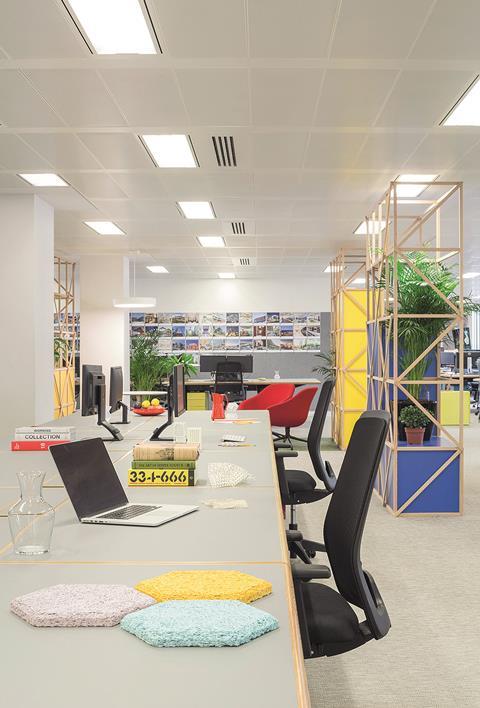
05 / Case study: Cundall’s london office
- Occupier: Cundall
- Business type: Engineering consultant
- Location: One Carter Lane, St Paul’s, London
- Project team: Studio Ben Allen, Cundall, Hush, QOB
Objectives
Cundall wanted an office that could accommodate all its London staff on one floor, seeking to create an open and inclusive community that would encourage collaborative working and put people at the heart of the process, as part of the company’s One Planet Living strategy. As an assessor for BREEAM, LEED and Green Star, Cundall was keen to try out the WELL standard – and what better way to test it than on its own employees?
Key challenges and successes
One of the biggest challenges in the fit-out project turned out to be probably one of its greatest successes. The WELL standard required Cundall to provide enough seating for one-third of its staff to sit down for lunch. In the old office there had been just one small bench in the kitchen, which no one really used; 90% of people were eating lunch at their desks. In the new office fit-out, the meeting area (dubbed “the town hall”) was placed at the heart of the workplace next to the reception. Now, less than 20% of staff eat lunch at their desks and the space is popular not only at lunchtime but also for informal meetings throughout the day. It has created a much closer community feel to the office and has been so successful that the concept has been replicated in all Cundall’s offices.
06 / The numbers
To provide a gauge of the potential construction fit-out cost premiums of obtaining a WELL Gold certification, we have analysed the current WELL standard against a notional fit-out project. We have assumed the space is taken from a BCO-compliant category A fit-out, with a category B fit-out rate of £100/�ڳ�². The workspace in our model covers 60,000ft2 over two floors with efficient floorplates and a regular core/atrium arrangement.
Our estimate suggests a cost uplift of between £3/ft2 NIA and £8/ft2 NIA to achieve WELL fit-out Gold. A number of potential specification upgrades drive this cost uplift, of which some examples are presented in figure 3.
| Baseline category B fit-out | £100/�ڳ�2 NIA |
|---|---|
|
Air Air-quality monitoring and low-VOC finishes |
£1.80-£4.80/�ڳ�2 NIA |
|
Thermal comfort Humidity control |
£0.40-£1/�ڳ�2 NIA |
|
Water Water tests and drinking water dispensers |
£0.30-£0.70/�ڳ�2 NIA |
|
Innovation Allowance |
£0.20-£0.50/�ڳ�2 NIA |
|
Movement Additional finishes |
£0.20-£0.50/�ڳ�2 NIA |
|
Communities New mother support room |
£0.10-£0.40/�ڳ�2 NIA |
|
Nourishment Additional signage |
£0-£0.10/�ڳ�2 NIA |
|
Category B fit-out + WELL Gold |
£103-£108/ft2 NIA |
- Key exclusions: Design/WELL certification fees, operational costs, water filtering
- Other budgets: Furniture, local amenities, daylight requirements
A key area is air quality, with a need for air sensors and the ability to display real-time data. Requirements for low-VOC finishes and extraction from print rooms further improve air quality. Additional signage and enhanced finishes are necessary to promote stair use and are included in the “movement” category. Additional humidity controls help with thermal comfort and some credits for innovation have been added. This includes a variety of performance tests to prove air quality as well as water and thermal performance.
There are a number of upgrades that can be achieved with no costs attached, for example because they should already be included in the base fit-out scope, especially if it follows the latest BCO guidelines.
Items such as design fees, WELL certification fees and operational costs (such as ongoing monitoring, submission of information, specific cleaning products, food offerings, fitness classes and education or support for employees) have been omitted from this estimate because they are not part of the construction cost budget. Another important example is furniture (part of category C works). The movement category calls for ergonomic desks and for 25% of workstations to be sit/stand desks.
The costs follow one possible pathway proposed by Cundall, but there are a multitude of combinations that could be adopted – each with their own cost implications.
07 / Conclusion
WELL is high on the agenda of most design team meetings these days –and rightfully so given the evidence about the importance of health and wellbeing in the workplace, as well as the benefits it brings to employees and the supporting business case.
This article suggests one way of achieving WELL Gold and the potential cost range of doing so, but the WELL ��ɫ����TV Standard provides a plethora of options for achieving an occupier’s objectives in its fit-out.
Given, among other things, the greater understanding of mental health nowadays, as well as the need for businesses to address productivity issues, the subject of healthy workplaces can only gain greater traction. No doubt the WELL standard will grow and develop in response to greater knowledge and feedback.
Acknowledgments
With particular thanks to our collaborators: Simon Wyatt and the team at Cundall, and Gary Martin, Colin Mooney and the team at the Crown Estate


























No comments yet